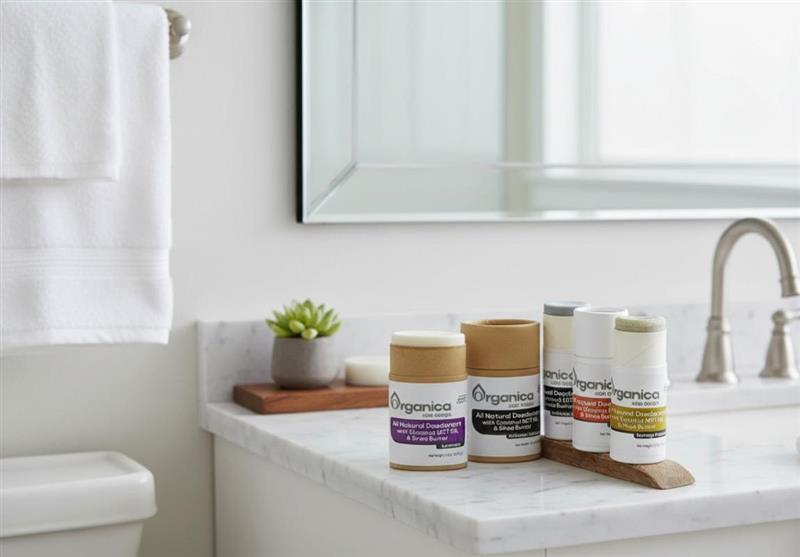
If you’ve recently made the switch to natural deodorant only to discover mysterious stains on your favorite shirts, you’re not alone. This frustrating but temporary issue affects many people during their transition to aluminum-free products. Understanding why it happens—and more importantly, what you can do about it—can help you navigate this adjustment period with confidence. While exploring natural alternatives, consider incorporating handmade organic soap, aromatherapy body soap, and natural face soap into your personal care routine for a holistic approach to clean living.
The Science Behind Natural Deodorant Staining
Natural deodorant staining isn’t a defect or sign that you’ve chosen the wrong product. Instead, it’s often the result of several interconnected factors that occur as your body adapts to a completely different approach to underarm care.
The Detox Factor: Your Body’s Adjustment Period
When you switch from conventional antiperspirants to natural deodorants, your body goes through what many call a “detox phase.” For years, aluminum-based antiperspirants have been blocking your sweat ducts, preventing natural perspiration. When you remove this barrier, several changes occur simultaneously:
– Increased Sweat Production: Your body may temporarily produce more sweat as it readjusts to natural perspiration patterns. This excess moisture can carry more oils and natural compounds from your deodorant into the fibers of your clothing.
– pH Imbalances: Your underarm’s natural pH may fluctuate during this transition period. These pH shifts can affect how deodorant ingredients interact with fabric, potentially leading to discoloration or staining.
– Bacterial Rebalancing: As your underarm microbiome adjusts to the absence of aluminum compounds, the changing bacterial environment can alter the chemical composition of your sweat, sometimes making it more reactive with certain fabrics or deodorant ingredients.
The Coconut Oil Connection
Many natural deodorants rely on coconut oil or fractionated coconut oil as a base ingredient. While these oils provide excellent moisturizing and antimicrobial properties, they can contribute to staining in several ways:
– Oil Transfer: Coconut oil, shea butter, and cocoa butter, commonly found in natural deodorants, can penetrate fabric fibers and become difficult to wash out thoroughly, much like the oils in handmade organic soap.
– Over-Application: Too much product can sit on your skin and transfer to your clothing, leading to stains. Natural deodorants often have a different consistency than conventional ones, leading users to apply more product than necessary.
– Temperature Sensitivity: Coconut oil melts at body temperature, which means it can become more fluid throughout the day and transfer more readily to clothing.
pH and Chemical Reactions
Some natural deodorants have a higher pH level, which can make them more alkaline and increase the likelihood of staining. The baking soda commonly found in natural deodorants has an alkaline pH that can react with certain fabric dyes or treatments, especially in synthetic materials. This reaction can manifest as yellowing, darkening, or other discoloration.
Why This Phase Is Temporary
Some users may never experience staining, while others may undergo a short transition phase. Either way, it’s part of your body adapting to a healthier, aluminum-free lifestyle. Most users find that sweat levels and odor improve overall after the adjustment.
The staining issue typically resolves itself within 2-4 weeks as your body adjusts to the natural deodorant. During this time:
– Your sweat production normalizes
– Your underarm pH stabilizes
– Your skin’s microbiome rebalances
– You learn the optimal amount of product to apply
Prevention Strategies: Stop Stains Before They Start
Application Techniques
– Use Less Product: Natural deodorants are often more concentrated than conventional ones. Start with a light application and increase only if needed.
– Allow Absorption Time: After applying your natural deodorant, give it a few minutes to absorb into your skin before getting dressed. This helps prevent the oils and other ingredients from immediately transferring.
– Apply to Clean, Dry Skin: Ensure your underarms are completely clean and dry before application to prevent product buildup.
Fabric Considerations
– Choose Natural Fibers: Try switching to cotton or bamboo blends, especially during the adjustment phase. Natural fibers are generally more forgiving and easier to clean than synthetic materials.
– Avoid White and Light Colors: During your transition period, opt for darker colors or patterns that won’t show stains as readily.
– Consider Undershirts: Adding a barrier layer can protect your outer garments during the adjustment period.
Stain Removal Solutions
If stains do occur, don’t panic. Many natural deodorant stains can be successfully removed with the right approach:
– For Fresh Stains: Blot (don’t rub) excess product immediately, pre-treat with liquid laundry detergent before washing, and wash in the warmest water safe for the fabric.
– For Set-In Oil Stains: If you experience oil stains, you can usually get them out with baby powder, dry detergent powder, or Dawn dish soap. Apply baby powder or cornstarch to absorb oils, let it sit for several hours, brush off the powder, and then treat with Dawn dish soap before washing.
– For pH-Related Discoloration: Pre-treat with white vinegar to neutralize alkaline reactions, soak in cold water with enzyme detergent, or consider professional cleaning for valuable garments.
Choosing Stain-Resistant Natural Deodorants
When selecting a natural deodorant, consider formulations that minimize staining risk:
– Look for Lower Oil Content: Products with less coconut oil or butter content may transfer less to clothing.
– pH-Balanced Formulas: Seek deodorants specifically formulated to have a skin-friendly pH and are free from harsh chemicals.
– Powder-Based Options: Arrowroot or cornstarch-based formulas may be less likely to stain than oil-heavy options.
– Clear Formulations: Avoid deodorants with heavy pigments or colorants during your transition period.
The Bigger Picture: Why It’s Worth It
While the temporary staining issue can be frustrating, remember that it’s a small price to pay for the long-term benefits of natural deodorant:
– No aluminum compounds blocking your body’s natural processes
– Gentler, skin-friendly ingredients
– Reduced risk of skin irritation and allergies
– Environmental benefits from cleaner formulations
– Better long-term odor control once your body adjusts
Final Thoughts
Natural deodorant staining is a common, temporary challenge that many people face during their transition away from conventional antiperspirants. By understanding the underlying causes—from detox phases to coconut oil transfer to pH imbalances—you can take proactive steps to minimize the issue and successfully navigate this adjustment period.
As you make this switch, consider integrating handmade organic soap, aromatherapy body soap, and natural face soap into your routine for a more comprehensive approach to skincare. These gentle, nourishing alternatives can enhance your self-care regimen while keeping your body fresh and clean.
Remember that everyone’s transition experience varies from one another. The key is patience, proper application techniques, and the knowledge that this phase will pass as your body adapts to its new, healthier routine. With the right approaches and realistic expectations, you can successfully transition to natural deodorant without sacrificing your favorite shirts—or your confidence.







